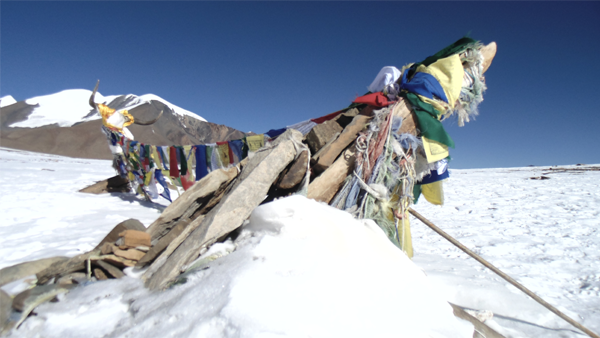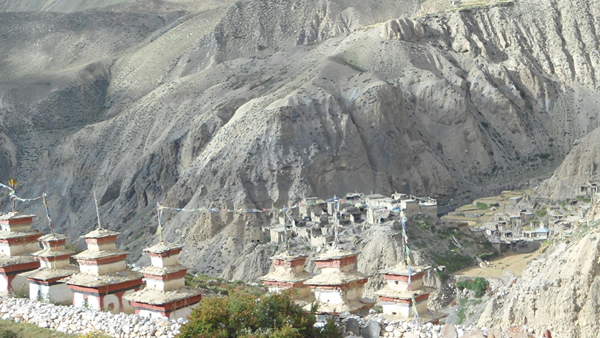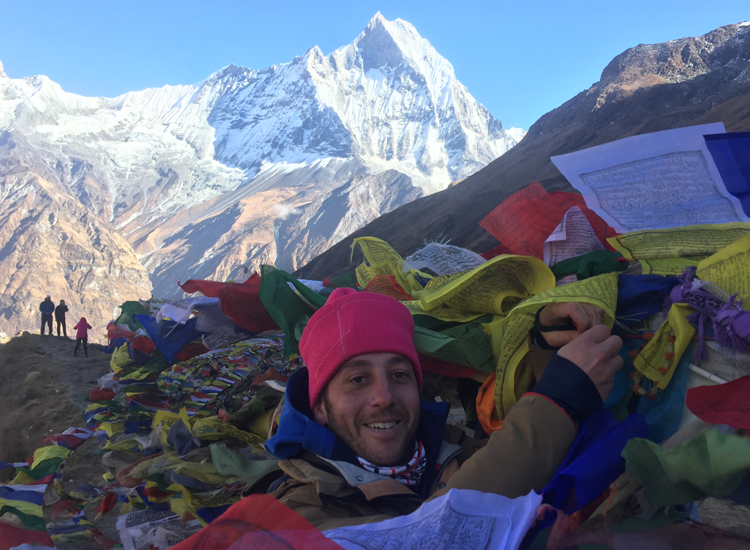
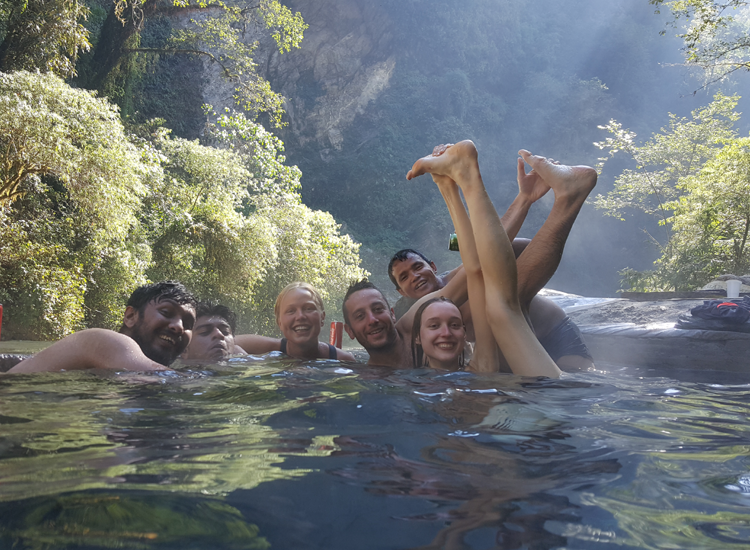
.jpg)

.png)

.png)
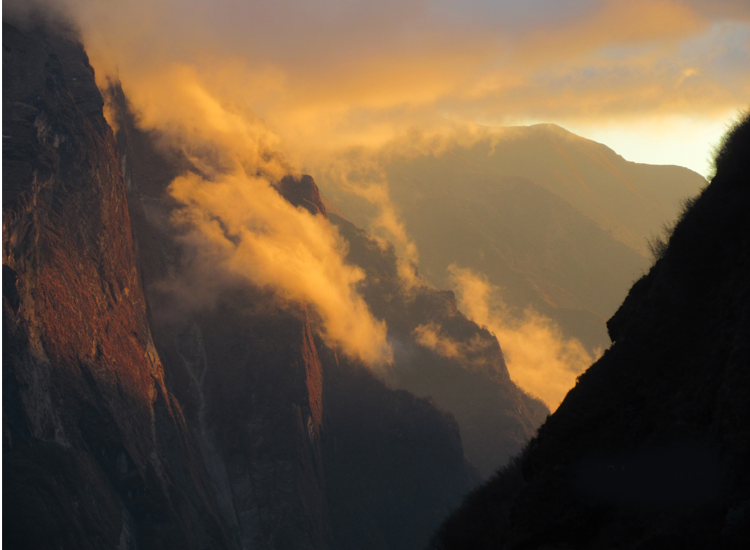
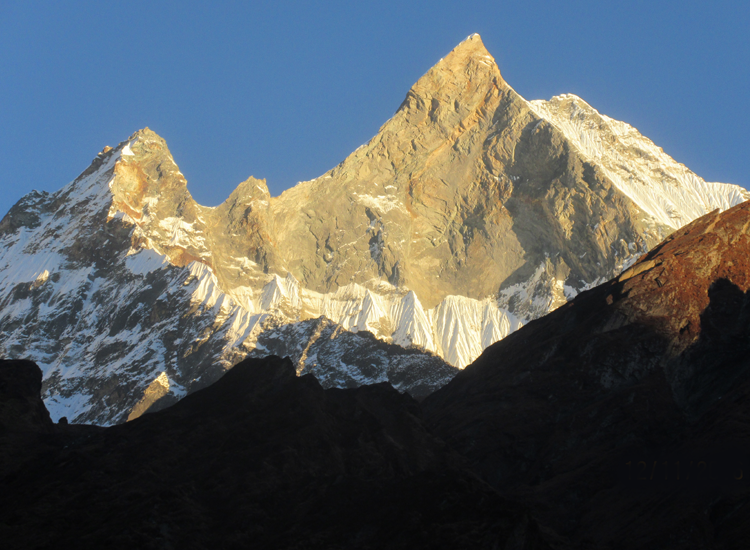
.png)


.jpg)

.png)

.png)


.png)
The Annapurna Base Camp Trek is one of our idea treks and we’d be delighted to help you explore this incredible region in Nepal.
Become acquainted with one of the most famous mountains in the world: Annapurna. With Incredible Himalayan Sherpa Adventure, you will experience the stunning Annapurna massif as well as the remarkable hospitality of the locals. Embark on of the most popular treks in Nepal and discover what Nepal has to offer.
Thanks to the popularity, the trail is very well developed, offers comfortable accommodation and warm hospitality of different ethnic groups. The sketched out itinerary 6 days, it is dedicated to for those travelers who able to walk and tolerance the elevation. But if would like to immerse in a nature thoroughly with deep breath then it is appreciate if you extend 4 days extra over the previous schedule and for that you should contact to the company. The itinerary is very flexible and can be extended as you wish. There are many worthwhile destinations close-by that can enhance your trekking adventure. We have guides specialized on this trip with extensive local knowledge. As with all our trips, they are happy to introduce you to the local culture and customs.
The Annapurna conservation area is the largest protected area in the country. The trail leads you through this unique eco system and our guides will highlight many of its stunning features.
The trail is centred on the famous Annapurna I (8091m) which is 10th highest peak in the world and the first 8000m peak to be climbed. The base camp itself is located near Annapurna South, with a perfect view of Annapurna and Mount Fishtail. Beyond the landscape, the conservation area also offers a remarkable range of wildlife, flora and fauna – an unforgettable experience of the Himalayan ecosystems.
A little highlight after the tiring trek: the trail reverts down to the valley to the Jhinu hot springs where you can enjoy a hot spring, relaxing bath to reflect on the journey. Annapurna base Camp 6 day’s trip dedicated to experienced trekkers and it commence and end at Pokhara .If you prefer company organize your trip from Kathmandu to Kathmandu, have a contact us.
Highlights:
- Impressive views of the Annapurna range
- Enjoy the unique eco system of the Annapurna conservation area
- Relax at comfortable lodges with good, locally sourced food and friendly locals
Itinerary
Day 01
Arrival in Kathmandu (1350m/4429 ft.)
Flying into Kathmandu is a memorable experience with the Himalaya spread out. Timepass is so quickly, enjoying the views of marvelous Himalayan ranges along with the world's highest peak Mount Everest while being on this flight. The flight will land at (TIA) Tribhuwan International Airport at 1350m after you will receive Nepal entry visa which can be obtained in advance or on entry and for the visa process at Kathmandu TIA, you will take around 45min, it depends on the number of people in a queue. For the Nepal entry visa information, have to visit this Nepal govt. official site Department of Immigration Nepal. After you will exit from the gate, where you will see our company representative waiting for you withholding placard written with the company name. Company representative welcomes you by offering the holy Tibetan scarf and transfer to the hotel in a private vehicle. It takes around 30min to reach at Thamel from TIA via means of transportation. The scenes of Pashupatinath(sacred Hindu temple), city, full of various vehicles, peoples make our journey more enjoyable and amazing, then we reach the hotel and take rest. Thamel is full of restaurants, shopping centers, and good accommodation. Trek briefing and afterward invited to a host family for welcome dinner.
[Included meals: welcome drink]
Overnight at hotel
Day 02
Free day in Kathmandu (1350m/4429 ft.)
We recommend you to take an extra day in Kathmandu on the second day of the trip. Due to several hours of flight travel, physical mentally could be exhaust. Therefore it is an ideal idea to stop a day in Kathmandu before starting your Himalayas trip and prepare for the trip. During the free day at Ktm, you can simply stay relax or to make your the day memorable you can do sightseeing tour on world's UNESCO Heritage sites or you can do 1hr Everest Mountain Flight tour or 3h30min Everest Helicopter tour or 1h30min Langtang Helicopter tour, rock climbing, etc.
[Included meals: Bed & Breakfast]
Overnight at hotel
Day 03
Drive - Pokhara(823m) - Berethanti(1025m/3362.861 ft.), drive 7hr+30m walk
We leave early and drive westwards to Pokhara. This town is set in a beautiful valley and is overlooked by the Annapurnas and Machhapuchhare, one of the most distinctive of the Himalayan peaks. We continue through Pokhara to Naya Pul and from there have a 30-minute (2km) walk to the village of Birethanthi, where we stay overnight. Birethanthi is a riverside village at the confluence of the Modi Khola and the Burungdi Khola.
Overnight at teahouse
Day 04
Trek to Ulleri [2050m/6725ft], 5-6hr walk
After breakfast in the teahouse, we head up the wide trail through bamboo forests and lush pastures to Sudami where you climb gradually up the side of the valley to reach Hile (1495m) where we receive lunch and continue to Tikhedunga (1540m). From here we descend to cross the Bhurungdi Khola before climbing the steep stone staircase to the Magar village of Ulleri. The place is perfect to sop the overnight for the views of Annapurna South and Machapuchhare.
Overnight at teahouse
Day 05
Trek to Ghorepani (2750m/ 9020ft.), 4hr walk
It is said that there are 33,000 steps, but this is the toughest section of the trek. As we climb, the peaks of Annapurna South and Hiunchuli emerge from behind the foothills. Pasture and cultivated fields start to give way to deep forests of oak and rhododendron. It should take about 3-4 hours to reach Banthanti (2824m) where we stop for lunch. Then after a break, we continue for another hour and a half to Ghorepani. One of the biggest villages in the area, the views of the Himalayas from here are amazing. You may see 360° views of Annapurna and Dhaulagiri Himalayas on a clear day. Dhaulagiri I, II, III, IV, V, Tukuche, Dhampus, Nilgiri, Annapurna South, Barah Sikhar, Machhapuchhre (aka Fishtail) are some of the major peaks seen from here.
Overnight at teahouse
Day 06
Hike to Poon Hill (3210m/10531ft.), & continue to Tadapani (2710m/8891ft.), 2h30m+5-6hr walk
Poon Hill is the major attraction of this area. Visiting Poon Hill early in the morning for the sunrise is a memorable experience. We start early to hike the hour up to Poon Hill in the morning to admire the sun rising over the Dhaulagiri and Annapurna ranges. After spending about half an hour or so on the top of this hill, we return to your lodge in Ghorepani for breakfast and continue to Tadapani.
From Ghorepani, our trail winds upwards along ridges and through pine and rhododendron forests first to Deurali (2960m) and then down to Banthanti before reaching Tadapani (2540m) on a trail that descends steeply through dense moss-covered forest rich with bird life.
Overnight at teahouse
Day 07
Trek to Chhomrong (2210m/ 7250.656 ft.),6-7hr walk
The trail descends from Tadapani, through dense rhododendron forest. Towering above the villages we see the mighty peak of Annapurna South, with the Fishtail facing it across the valley. Chhomrong (2040m) is a Gurung village and the last permanent settlement on the way to the Sanctuary.
Overnight at teahouse
Day 08
Trek to Dovan (2500m/8202ft.), 5-6hr walk
The trail from Chhomrong descends first on a stone staircase to cross the Chhomrong Khola and then climbs steeply on another stone staircase out of this side valley to Sinuwa, where we enter the main Modi Khola Valley. From Sinuwa the trail descends on stone steps through dense jungle and then undulates to lunch at Bamboo, a cluster of lodges in a forest clearing. The forest around us is full of bamboo thickets. These are cut extensively to make 'dokos' - the carrying baskets as used by our porters - and woven mats for floors and roofing. Undulating further through the bamboo forest we reach Dobhan at 2,500m, another small clearing in the forest where there are several teahouses.
Overnight at teahouse
Day 09
Trek to Machhapuchare Base Camp (3700m/12135ft.), 4-5hr walk
A tough day today as we walk above 3,000m. The trail continues up through the forest, passing the lodges at Himalaya Hotel. From here the trail gets steeper and rockier as we climb up past Hinko Cave, where the first expeditions to the Base Camp used to camp. Crossing a ravine, the trail continues to climb steeply among boulders, leaving the trees behind us. We have lunch at Deurali and from here the valley broadens out and the scenery becomes wilder as we approach the gates of the sanctuary. From Deurali there are two trails. The one on the left side of the valley is the main trail but especially in spring when there is a lot of snow it is not used and an alternative trail on the right side of the valley is used. Your leader will decide which trail to use. Both trails finally meet for the last 1.5hr climb up between the heights of Hiunchuli and Machhapuchhare, to Machhapuchhare Base Camp (3,700m), where we spend the night. The views are stupendous and the panorama includes Huinchuli, Annapurna 1, Annapurna 3, Gangapurna and Machhapuchhare.
Overnight at teahouse
Day 10
Trek to Annapurna Base Camp (4,130m/13,545ft), 2-3hr walk
In the early morning, we walk for 2 hours up to Annapurna Base Camp (4,130m), surrounded by the snow-capped peaks of some of the highest mountains in the world. Hiunchuli, Annapurna South, Annapurna Fang, Annapurna 1 and 3, Gangapurna and Machhapuchhare all encircle us with unbroken soaring ramparts but for the route by which we entered. The sunset and sunrise are truly magnificent in this mountain arena. We spend the day in this special place with a chance to watch the sunrise the following morning. There should be time to make an excursion to the ridge overlooking the base camp from which Sir Chris Bonington led the ascent of Annapurna's South Face.
Overnight at teahouse
Day 11
Trek back to Bamboo(2340m/7677.165 ft.),6-7hr walk
A long and mostly downhill day as we leave the Sanctuary. We follow the same trail back to Machhapuchhare Base Camp and further down to Deurali. Entering the forest, we descend slowly and carefully on a rocky trail through Himalaya and Dobhan back to the lodge at Bamboo.
Overnight at teahouse
Day 12
Trek to Jhinu Danda(1780m/5839.895 ft.), 5-6hr walk
A rollercoaster walk today with lots of ups and downs. We start with a climb up to Sinuwa, then we descend to the river and climb back up the stone steps to Chomro. A final steep descent on stone steps brings us to Jhinnudanda. 20m down, there are some Natural Hot springs, where we visit and take bath; getting there involves descending for 20m down to the river, and the climb back up takes a little longer (around 30m).
Overnight at teahouse
Day 13
Trek to Siwai(1070m/3510ft.) & drive to Pokhara(823m), 3hr walk+4hr drive
The trail today undulates down the Modi River Valley. We follow the valley down to the road head at Sinwai. If the road is in good condition, we will pick up our transport here (sometimes our vehicle cannot get to here) and drive back to Pokhara. If we have to walk to Birethanthi this will add an additional 3 hours/10 km.
Overnight at teahous
Day 14
Drive back to Kathmandu (1350m/4429 ft.),6hr drive, transfer hotel
We will follow the same highway through beautiful rivers, hills and small Nepalese settlements. The drive will take about 7 hours to drop us in Kathmandu. Form the tourist bus park you will be transferred to your hotel. In the evening you can explore the town probably buying souvenirs. Flying to Kathmandu is an optional add-on service to save some time and to avoid a long drive back to Kathmandu.
Overnight at hotel
Day 15
Final Departure, transfer to Airport
Representative of IHSA will drop off you at the airport by private vehicle.
[Included meals: Breakfast]
Join us for the trips 2025
Fixed Departure Tours For 2024
| 21 May 2022 from Pokhara |
04 Jun 2022 in Pokhara |
from €525 |
Available | Join Now |
| 27 May 2022 from Pokhara |
15 Jun 2022 in Pokhara |
from €525 |
Available | Join Now |
| 07 Sept 2022 from Pokhara |
21 Sept 2022 in Pokhara |
from €525 |
Available | Join Now |
| 13 Sept 2022 from Pokhara |
28 Sept 2022 in Pokhara |
from €525 |
Available | Join Now |
| 21 Sept 2022 from Pokhara |
5 Oct 2022 in Pokhara |
from €525 |
Available | Join Now |
| 27 Sept 2022 from Pokhara |
11 Oct 2022 in Pokhara |
from €525 |
Available | Join Now |
| 07 Oct 2022 from Pokhara |
21 Oct 2022 in Pokhara |
from €525 |
Available | Join Now |
| 13 Oct 2022 from Pokhara |
27 Oct 2022 in Pokhara |
from €525 |
Available | Join Now |
| 21 Oct 2022 from Pokhara |
04 Nov 2022 in Pokhara |
from €525 |
Available | Join Now |
| 25 Oct 2022 from Pokhara |
08 Nov 2022 in Pokhara |
from €525 |
Available | Join Now |
| 28 Oct 2022 from Pokhara |
11 Nov 2022 in Pokhara |
from €525 |
Available | Join Now |
| 07 Nov 2022 from Pokhara |
21 Nov 2022 in Pokhara |
from €525 |
Available | Join Now |
| 13 Nov 2022 from Pokhara |
27 Nov 2022 in Pokhara |
from €525 |
Available | Join Now |
| 23 Nov 2022 from Pokhara |
07 Dec 2022 in Pokhara |
from €525 |
Available | Join Now |
| 27 Nov 2022 from Pokhara |
11 Dec 2022 in Pokhara |
from €525 |
Available | Join Now |
| 07 Dec 2022 from Pokhara |
21 Dec 2022 in Pokhara |
from €525 |
Available | Join Now |
| 10 Dec 2022 from Pokhara |
24 Dec 2022 in Pokhara |
from €525 |
Available | Join Now |
| 12 Dec 2022 from Pokhara |
26 Dec 2022 in Pokhara |
from €525 |
Available | Join Now |
| 7 Mar 2023 from Pokhara |
21 Dec 2023 in Pokhara |
from €525 |
Available | Join Now |
| 13 Mar 2023 from Pokhara |
27 Mar 2023 in Pokhara |
from €525 |
Available | Join Now |
| 18 Mar 2023 from Pokhara |
1 Apr 2023 in Pokhara |
from €525 |
Available | Join Now |
| 23 Mar 2023 from Pokhara |
6 Apr 2023 in Pokhara |
from €525 |
Available | Join Now |
| 29 Mar 2023 from Pokhara |
12 Apr 2023 in Pokhara |
from €525 |
Available | Join Now |
| 7 Apr 2023 from Pokhara |
21 Apr 2023 in Pokhara |
from €525 |
Available | Join Now |
| 13 Apr 2023 from Pokhara |
27 Apr 2023 in Pokhara |
from €525 |
Available | Join Now |
| 19 Apr 2023 from Pokhara |
2 May 2023 in Pokhara |
from €525 |
Available | Join Now |
| 23 Apr 2023 from Pokhara |
6 May 2023 in Pokhara |
from €525 |
Available | Join Now |
| 27 Apr 2023 from Pokhara |
10 May 2023 in Pokhara |
from €525 |
Available | Join Now |
| 7 May 2023 from Pokhara |
21 May 2023 in Pokhara |
from €525 |
Available | Join Now |
| 13 May 2023 from Pokhara |
27 May 2023 in Pokhara |
from €525 |
Available | Join Now |
| 19 May 2023 from Pokhara |
3 Jun 2023 in Pokhara |
from €525 |
Available | Join Now |
| 23 May 2023 from Pokhara |
7 Jun 2023 in Pokhara |
from €525 |
Available | Join Now |
| 27 May 2023 from Pokhara |
11 Jun 2023 in Pokhara |
from €525 |
Available | Join Now |
Note: We are flexible to customize the trip itinerary, dates as per your time frame, service standard etc.
Location
See Our Other Offers
We offer 3 packages: Basic, comfort & Full Board. Our Basic takes care of your trek, comfort include trek with your stay in Kathmandu along with all airport transfers personally while Full Board include entire meals in the mountains during the trek. Three can be flexibly adjusted to your requirements.
Basic Offer
Price : €525 per person with group size of 2
- Trek with an English speaking govt licensed trekking guide
- 1 porter (betn two clients) to carry your luggage during the trek (max 24 kg; i.e. 12kg pP)
- Accommodation during the trek in carefully selected teahouses as per the itinerary
- Private vehicle(Pkr-Nayapul & private jeep Siwai-Pkr)
- Duffel bag and trekking map
- Trekkers Information Management System [TIMS] registration card
- Annapurna Conservation Area Entry Permit
- Necessary paper works, all government, and local taxes
- Farewell dinner in Kathmandu by the host family at Typical Nepali Cultural Restaurant
- First aid medical kit, oxymeters to check pulse, heart rate & oxygen saturation carried by guide
Comfort Offer
Price: €635 per person with group size of 2
As Basic and
- 2N in 3* and 1N in 4* hotel in KTM on B/B plan as per the itinerary [upgrade possible]
- Airport pick up & drop off personally
Full Board Offer
Price: Have a kindly make an enquiry for the Full Board tour cost. Because the cost depends on the meals chosen by you.
As Comfort and
- Full board meals in the mountains during the trek
Group Discount:
There is a further discount for larger groups. Please contacts us for details at mytrek2nepal@gmail.com
Trek Duration:
The Trek duration can be shorten or extend depending on time and fitness
Excluded Services
- International Airfare to and from your country
- Nepal visa (USD 25 for 15 days and USD 40 for 30 days, two passport photographs required). For the further more information, have visit Nepal Immigration Department official website.
- Insurance - Following stated things must be submit while you do trips through (IHSA)
- You must submit copy of your insurance certificate included standard policies that covers trekking activities up to 5000m
- Your Insuarnce policy must cover accidents, medical expenses, and emergency evacuation including helicopter rescue upto 5000m and it is excluded in the trip price
- At the time of you do Insurance you should read the policy carefully whether your requirements are included or not
- IHSA also recommends your insurance policy covers cancellation, curtailment and loss of luggage and personal effects
- Any alcoholic beverages, cold drinks and boiled water as well as snacks, deserts etc. during the trek
- Tipping is a culture in Nepal and is expected by your staff (guides, porters, drivers)
- Hot shower, wifi, battery charges (available at extra cost in lodges, sometimes free)
- Unforeseen expenses not under our control such as flight cancellations or delays, weather-related issues, illness during the trek, rescue costs, etc
- Any other costs not specifically included. Please feel free to ask if in doubt
Equipment Lists
Trekking Equipment
Have a kindly bring following stated equipment for the camping/tented trek. The equipment you can buy in Kathmandu with different quality in good price.
Luggage:
01 large duffel bag: The Luggage is for to carry all your personal gear on the trekking. Should be strong and durable. The best size would be around 30" x 14", with a full-length zipper and handles.
1 rucksack or day pack: The bag is for to accommodate a sweater, rain gear, water bottle, camera and accessories and any miscellaneous items you need to have during the day. We recommend a pack with at least 1450cu. In capacity, or smaller if you are not carrying a large amount of camera equipment.
Head and Face Gear:
1. Sunhat
2. A Bandana
3. Sunglasses
4. Warm hat
5. Sunscreen with a very high SPF factor
6. Lip balm with a high SPF factor
7. An emergency light
Hands:
1. Lightweight gloves
Inner Clothing:
1. T-shirts
2. Thermal underwear- Top and bottom. Synthetic is best
3. Underwear
4. 2 shorts
5. 2 Trousers- (comfortable) One thin, one thick and warm
Outer Clothing:
1. down Jacket
2. Fleece Jacket (or a windproof jacket)
3. Waterproof jacket with a hood (or a poncho)
4. Waterproof pants
5. Baggy pants
6. 2 pairs of gloves/mittens (1 thin and 1 thick)
7. 1 sweater to be worn under the fleece jacket
Footwear:
1. Light weight walking boots- (leather is recommended)
2. Spare laces
3. 2 pairs of thick woolen socks.
4. 2 pairs of thin socks to be worn under the woolen socks
5. One pair of sandals or comfortable shoes for camp
Drinking Equipment:
1. Water Bottle
Purification equipment-Boiled drinking water will be provided but further purification with iodine or purification tablets is highly recommended.
Sleeping and Carrying Equipment:
1. 30-40 liter daypack
2. Water Proof Bag-A water proof bag to cover the rucksack
3. Sleeping Bag- Please brings a bag that can resist temperatures as low as -15 degrees Celsius
Personal Medical Kit:
1. Bandage for sprains
2. Plasters/Band-aids
3. Iodine or water filters
4. Moleskin/Second skin - for blisters
5. Antiseptic ointment for cuts
6. Anti-bacterial throat lozenges (with antiseptic)
7. Aspirin/paracetamol - general painkiller
8. Oral rehydration salts
9. Broad-spectrum antibiotic (norfloxacin or ciprofloxin)
10. Anti-diarrhea medication (antibiotic)
11. Diarrhea stopper (Imodium - optional)
12. Diamox (altitude sickness - can be bought in Kathmandu)
13. Sterile Syringe set (anti-AIDS precaution)
Extras/Luxuries:
1. Binoculars
2. Reading book
3. Trail Map/Guide book
4. Journal & Pens
5. Travel game i.e. chess, backgammon, scrabble
Toiletries:
1. 1 medium sized quick drying towel
2. Toothbrush/paste (preferably biodegradable)
3. Multipurpose soap (preferably biodegradable)
4. Deodorant
5. Nail clippers
6. Face and body moisturize
7. Feminine hygiene products
8. Small mirror
Information
Nepal Visas
You need visa for Nepal, which can be obtained in advance or on entry. If you wish to apply before departure the current visa cost is £20 for a 15 day visa and £35 for a 30 day visa for UK passport holders. The current cost of a visa on arrival is US$25 for 15 days, US$40 for 30 days or if extending your stay $100 for 90 days. All are multiple entry. The visa on arrival fee can be paid for in cash in US Dollars, Pounds Sterling or Euros. You will also need a passport photo. Application forms are available in the immigration hall (or for electronic passports there are visa registration machines which, after inserting your passport, automatically fill out a form for you). You must firstly join the queue to pay the visa fee, and then go to the relevant immigration desk to obtain your 15, 30 or 90 day visa stamp. There can be long queues for visas on arrival.
Insurance
Following stated things must be submit while you do trips through Incredible Himalayan Sherpa Adventure(IHSA)
√ You must submit copy of your insurance certificate included standard policies that covers trekking activities up to 5000m.
√ Your Insuarnce policy must cover accidents, medical expenses, and emergency evacuation including helicopter rescue upto 5000m and it is excluded in the trip price.
√ At the time of you do Insurance you should read the policy carefully whether your requirements are included or not.
√ IHSA also recommends your insurance policy covers cancellation, curtailment and loss of luggage and personal effects.
Weather
The main trekking season in Nepal is from October to mid-May when daytime temperatures at most altitudes are generally comfortable for walking, the sky is clear much of the time and rain and snow are occasional occurrences. Daytime temperatures will vary from 15ºC to 35ºC in the Kathmandu Valley to around 10ºC at 3,600m and progressively lower the higher we go.
Different seasons offer different advantages for trekking.
Post Monsoon/autumn: Mid-September to November. This is the main trekking season in Nepal. Day temperatures in Kathmandu are approximately above 20ºC. Skies are usually clear and days on trek are sunny and mild with clear mountain views. At the highest altitudes although the days can be nice and sunny the temperatures can drop to 10ºC and much lower. Nights will be colder with temperatures dropping as low as minus 10ºC and lower at the highest altitudes.
Pre-monsoon/spring: March to May. Both day and night temperatures will be warmer in general but haze will often build up in the afternoons. It is very hot in the lowlands and temperatures rise to 35ºC in Kathmandu. Flowers bloom in this season and this is one of the reasons people chose to trek in spring.
Snow can be expected on any departure, usually at the higher altitudes. Summit day will be a very early start (usually about 2am) and will be extremely cold. Although mostly it is calm and clear on summit day the mountain does occasionally get high winds. You need to be equipped for temperatures as low as minus 25ºC plus wind chill on summit day.
Please remember that in any mountain area the weather is never wholly predictable and you should be prepared and equipped to deal with any differences in weather beyond the conditions described above.
Drinking Water
Staying hydrated is important when undertaking any physical activity but particularly so at altitude where it is generally recommended to drink at least 3-4 litres per person per day.
We strongly encourage you not to buy bottled water on trek as this contributes to the growing problem of plastic pollution in Nepal’s trekking areas.
All tea houses will provide cold water free of charge, if requested. Although this should not be drunk untreated, we recommend that you bring a reusable bottle with a wide opening (Nalgene or similar) with you and use a SteriPEN to treat it with. A SteriPEN is a handheld UV water purifier – small, lightweight and battery powered so easy to pack for a trek. In Nepal’s trekking regions most of the bottled water isn’t strictly ‘mineral water’ anyway but is UV treated, so it’s exactly the same technology. It’s quick to use, far more effective than purification tablets, and the water is ready immediately. It’s fine to use a SteriPEN on non-boiled water so long as it isn’t cloudy or full of sediment (which is uncommon in these regions).
SteriPENs are widely stocked on Amazon, outdoor shops and other online retailers; look for the latest models but avoid USB charging ones. Better still, a SteriPEN will pay for itself over the course of the trek and you won’t leave behind a single plastic bottle – you will end up spending the same or even less than you would on bottled water, plus you can keep it for future trips.
If you prefer not to invest in a SteriPEN, the tea houses also sell boiled water for approx. Rs150-300 per litre (the price increases the higher you trek) which should not require treating. This is also perfect for a bedtime refill as it can double up as a hot water bottle.
While camping boiled water is supplied for drinking.
Money and Gratuity
Money and Gratuity; It is best to bring a mixture of cash and traveler’s checks in a major currency [some currencies are not convertible to NPR]. USD, GBP, CAD, EUR, and AUD are generally fine. Ensure you have also small denominations. As a guideline for baseline spending money we suggest USD 8 - 10 per meal in Kathmandu / Pokhara and USD 30 – 35 per day whilst trekking in the Annapurna region (if you drink or smoke or plan some major shopping this could be higher). You should exchange enough money into Nepalese Rupees to last the entire time of your trek BEFORE leaving Kathmandu. There are no exchange facilities in the villages along the trail but plenty of money changers in KTM.
Gratuity is, Since the 1960s when trekking in Nepal was developed, there has been a tradition for groups and independent visitors to gratude their crews at the end of a trek but gratuity are not included in the trip price. If you are happy with the performance of the trekking staff, we suggest the following as a minimum: USD 7 per day of the wages or around one day’s wage for each week on a trek. As a rule, and through tradition, the head cook should get a little more than the porters and ‘Sherpa’ and kitchen crews. The Sardar and Leader/Guide should get a little more again.
FAQs
Preparation
Q. Where can I get a visa to enter Nepal?
You are availble it at TIA aiport. However, in response to the current Covid situation, rules for arriving visitors may change frequently and sometimes without notice. It may be necessary to obtain a tourist visa in your own country before travel. For updated information on visas, please check the Nepal Tourism Board and the Immigration of Nepal Immigration websites.
Reservation
Weather
Price
525Duration
Season
Region
Grade
Altitude
Walking
Accommodation
Trip Type
Transportation

Certificate of Excellence
Based of services & reviewTrek Map
Travel With IHSA?
Need More help ?
Talk to our travel experts by phone, email, WhatsApp/Viber, WeChat! We love to talk travel ! We're here to help and happy to assist you with your booking and make your dream come true.
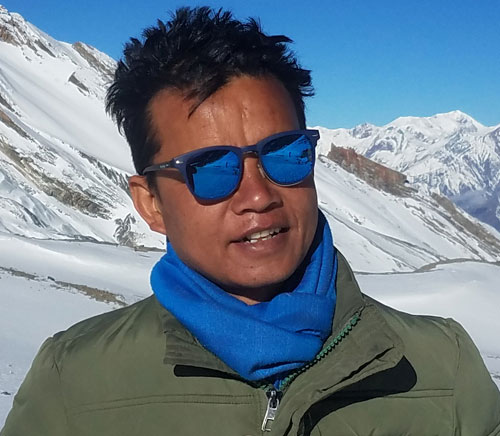
Mr. Tsering D. Sherpa
(National Mountain Leader)
Mountaineering, Treks & Tours
- +977-9862258888
(WhatsApp,Viber)7/24 - mytrek2@gmail.com
info@himalayansherpaadventure.com


